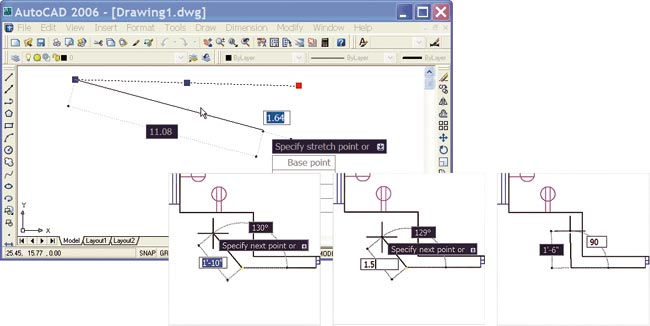
You then create the block geometry using standard AutoCAD commands, add parameters to the geometry (such as distance, rotation point, or visibility), and then add actions to specify how each property will change. The existing drawing disappears and a new drawing area appears with a beige background. After specifying the name for the new block, AutoCAD shifts into a new block definition mode. To do so, you use a new Block Definition Editor and Block Authoring palette. But creating dynamic blocks is not a trivial task. You insert dynamic blocks the same way as you insert an old fashion block, and using dynamic blocks is pretty straightforward. Next, imagine grabbing the end of the table, stretching it, and having additional chairs automatically added. Imagine inserting a conference table and being able to select the type of chairs arranged around its perimeter. Or you can create a block that automatically aligns itself with adjacent geometry when you insert it.ĭynamic blocks offer endless possibilities. Dynamic blocks can be defined with multiple insertion points that you can cycle through during insertion. Upon insertion, you can choose which representation to use.

The idea is to reduce the number of individual blocks within your block library.ĭynamic block definitions can contain multiple representations of a particular symbol, such as top, front, and side views, or multiple sizes. Once defined, you can insert the block and then change its size and appearance dynamically within the drawing. AutoCAD’s new dynamic blocks let you define a single block with multiple variations.

The problem with blocks, however, has been that you need a different block for each instance of similar but slightly varying geometry, such as hex, cap, and machine screws. Most users have extensive libraries of blocks for all manner of standard components and symbols. Again, users have complete control over the operation and appearance of this new feature. The box background is coloured blue for a window selection and green for a crossing window. In addition, when using a selection window or crossing window to select objects, AutoCAD now adds a transparent box. When you move your cursor over an object, the object immediately highlights, making it easy to differentiate, for example, between individual lines and arcs and an entire polyline. Any user who has worn out their ESC key because they often select the wrong object will be delighted with AutoCAD’s new rollover highlighting feature. So much so, that they may decide to turn off the command line entirely to regain additional drawing real estate.ĭynamic input lets users remain focused on the drawing rather than constantly having to look at AutoCAD’s command promptĪ subtler but no less significant improvement involves the way AutoCAD lets you select objects. Pressing F12 (or clicking a new DYN button on AutoCAD’s status bar) toggles dynamic input on and off, but we think most users will quickly find this new way of working to be an incredible boon to productivity. You can control how and when the dynamic input fields appear, such as switching between Cartesian or polar coordinate input and changing the size and transparency of the dynamic prompts. When commands offer multiple options, pressing the down-arrow key displays a drop-down list of those options right at the cursor location. For example, to draw a line, you can select a starting point, drag the cursor a bit, type a distance value, press TAB to switch to the angle field, and then type the angle value, all without ever taking your eyes off the drawing. But perhaps the single most useful enhancement is something Autodesk is calling dynamic input.Īs you draw, the command prompt appears adjacent to the cursor, and you can dynamically view dimension values, such as length and angle, and type values into dynamic input edit boxes. Heads-up designĪnyone who ever thought that it would be difficult to add significant new functionality into a 20+ year old CAD product like AutoCAD will be very surprised at the many improvements and new features Autodesk has come up with. So anything that improves 2D drafting is a big deal. Although a large percentage of users have moved to three-dimensional solid modelling – using products such as Autodesk Inventor – millions continue to create 2D drawings using AutoCAD.

If there is an overriding theme to the new release, it’s a focus on improving the productivity of users doing many of the everyday tasks of two-dimensional drafting.

Dynamic blocks can contain different visual representations or sizes of an object


 0 kommentar(er)
0 kommentar(er)
